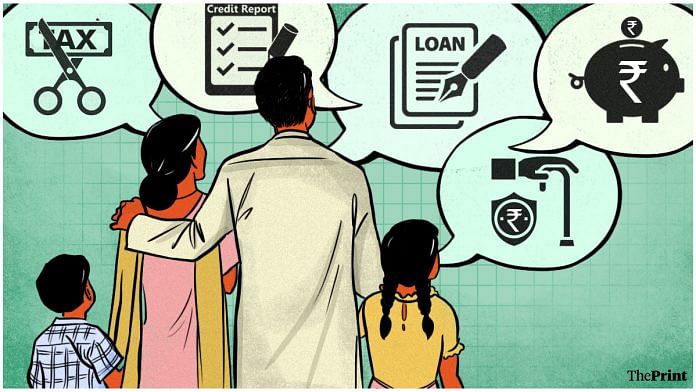An interesting development in the Indian credit market has been the shift of bank lending from businesses to households. Is this a sign of prosperity, or are we waiting for another credit bubble to burst? Many numbers are before us, but they don’t tell us the full story. While the RBI has been consistently putting out credible data in the public domain about some of these aggregates, they should go a step further and release information about the full credit portfolio of households relative to their incomes; to the extent that RBI itself has visibility on these metrics. This will help us assess the true vulnerability, if any, of the current banking portfolio. Policy changes are only as good as the data they are based on.
Households are borrowing
We are used to thinking that banks typically lend to larger firms, and households borrow from the informal sector. We are also used to thinking that when households borrow from banks, it is mostly for housing or vehicle loans, where the house or the vehicle acts as collateral. We may concede that, perhaps, households also sometimes borrow for consumer durables.
If this is what you think, then it is time to revise these misconceptions. Based on data from RBI’s report on Trends and Progress of Banking in India, Basic Statistical Returns and Financial Stability Report, It’s safe to say that we are witnessing a never seen before credit market. Banks are lending to households much more than corporations. The compounded annual growth rate in bank credit to the household sector was almost 15 per cent, while to non-financial corporations was 4.2 per cent between December 2014 and 2023.
Nearly half of the lending by non-banking finance companies is also going to households. As of December 2023, the total outstanding credit for personal loans by banks and NBFCs was about Rs 70 lakh crore. Of this, Rs 36 lakh crore (51 per cent) was housing loans, and Rs 1.6 lakh crore (2 per cent) was gold loans. This is significant because it suggests that about half of the outstanding credit by financial institutions has collateral backing it. Nearly Rs 32 lakh crore (46 per cent) is unsecured. In the class of unsecured loans, the largest share at Rs 17 lakh crore (24 per cent) is a category called Other Personal Loans. It is unclear what these loans are towards.
Financial liabilities of households increased from 3.8 per cent of GDP in 2021-22 to 5.8 per cent in 2022-23. This has been the driver of the fall in household net financial savings. These numbers do not necessarily mean that households are not borrowing from the informal sector. The overall size and source of the informal sector is difficult to estimate.
Also read: Digital lending has got a bad rap, but don’t throw the baby out with the bathwater
Households’ ability to repay
On the one hand, higher borrowing by households can mean that they are better able to do consumption smoothing—they feel confident enough in their future prospects to be able to service these loans. On the other hand, increased borrowings could be a sign of stress. Households may find it difficult to keep up their consumption profile and resort to obtaining unsecured loans to keep their life going. Perhaps ready availability through digital lending and other platforms makes it easier to take on debt. As long as households are able to repay, it shouldn’t matter.
The larger question is, how do we know if the increased leverage of households is an indicator of bad times to come?
The RBI Financial Stability Report of December 2023 offers a perspective. Gross non-performing assets of the banking system were at 3.9 per cent in March 2023 and had fallen further to 3.2 per cent in September 2023. The gross NPA of personal loans was 1.3 per cent, much lower than agricultural loans at 7 per cent and industrial loans at 4.2 per cent. It appears that households are able to service their loans.
One measure of sustainability of household debt is the Debt-Service ratio (DSR) which depends on the interest rate, the maturity of loans, the stock of debt and the gross disposable income of households. The RBI Financial Stability Report estimates the DSR of households to be 6.7 per cent at the end of March 2023. Assuming that RBI’s assumptions on interest rate and residual maturity are correct, this report indicates that there is nothing to worry about.
Also read: India doesn’t need new taxes to uplift its poor. Existing welfare schemes are doing well
And yet, is there cause for concern
There are a few indications that we may have to be more cautious than the Debt-Service Ratio suggests.
First, RBI itself is taking actions that indicate that it is concerned about the high leverage of households and exposure of banks. In March this year, it warned against “exuberance” in retail lending. This week, it asked fintechs not to pursue blistering growth and suggested that they should reset their growth to 15-20 per cent, instead of the current 35-50 per cent. One does not expect a modern regulator to outline either business models or targets for firms. And yet, the RBI felt inclined to do so given the current situation. In November last year, it increased the risk weights of certain categories of personal loans to 125 per cent from the earlier 100 per cent.
Second, there was an increase in the number of households borrowing for debt repayment between 2015 and 2022. This number is likely to have risen since then.
Third, there seems to be some moderation in the growth of the FMCG sector in 2024. One could speculate that this is because of moderation in either the income or cash-flow situation of households. These conflicting data points indicate that we still haven’t been able to get to the bottom of the story. Only more granular data on households’ balance sheets can help us get there.
(Edited by Theres Sudeep)



